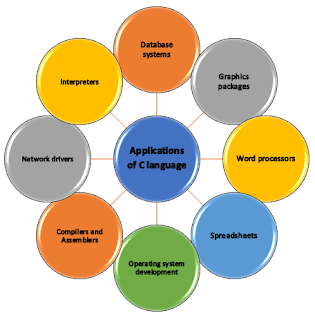C programming language is a
structured programming language, developed by Dennis Ritchie at Bell
Laboratories in 1972.
It
has been written in assembly language, belonging to middle level programming
language.
It’s features were derived from
an earlier language called “B” (Basic Combined Programming Language – BCPL).
C language was invented for
implementing UNIX operating system.
In 1978, Dennis Ritchie and Brian
Kernighan published the first edition “The C Programming Language” and commonly
known as K&R C.
In 1983, the American National
Standards Institute (ANSI) established a committee to provide a modern,
comprehensive definition of C. The resulting definition, the ANSI standard, or
“ANSI C”, was completed late 1988.
This language is used for developing system applications that forms a
major portion of operating systems such as Windows, UNIX and Linux.
Some of the features of C
language :-
·
Reliability
·
Portability
·
Flexibility
·
Interactivity
·
Modularity
·
Efficiency
and Effectiveness
Development of Unix System
The PDP-11 version of Unix system
was written in assembly language. Assembly languages are low-level programming
languages that are specific to a particular computer architecture. They are
hard to write and understand.
The developers of Unix Operating
system (including Dennis Ritchie and Stephen C. Johnson) decided to rewrite the
system in B language. However, B couldn’t suffice some of the features of
PDP-11, which led to the development of C.
In 1972, the development of C
started on the PDP-11 Unix system and
first appeared in Version 2 Unix. A large part of Unix was then
rewritten in C and the compiler for
the Honeywell 6000 was
written within the first year of C's history. By 1973, C was powerful enough to be used in Unix
Kernel. Dennis Ritchie and Stephen C. Johnson made further changes to the
language for several years to make it portable in Unix Operating system.
ANSI C
With the rapid growth of C
language, it was necessary to be standardized. All the three standards given
below are also known by the name of ANSI C
:-
C89 :- The first standard of C was
published by American National Standards Institute (ANSI) in 1989. This version
is commonly popular as C89. C89 is supported
by current C compilers, and most C code being written today is based on it.
C99 :- In late 1990’s, several new
features including inline functions, several
new data
types (including
long, long
int and a complex type to represent complex
numbers), variable-length arrays and flexible array members,
improved support for IEEE
754 floating point, support for variadic macros (macros
of variable arity),
and support for one-line comments beginning with //.
C11 :- The C11 standard has new
features like type generic macros, atomic operations, anonymous structures, multi-threading, and bounds-checked functions.
C18 :- This standard is published in June 2018, C18 is the current
standard for the C programming language. It introduces no new language
features, only technical corrections and clarifications to defects in C11.
Applications of C language
·
Database systems
·
Graphics packages
·
Word processors
·
Spreadsheets
·
Operating system development
·
Compilers and Assemblers
·
Network drivers



Comments
Post a Comment